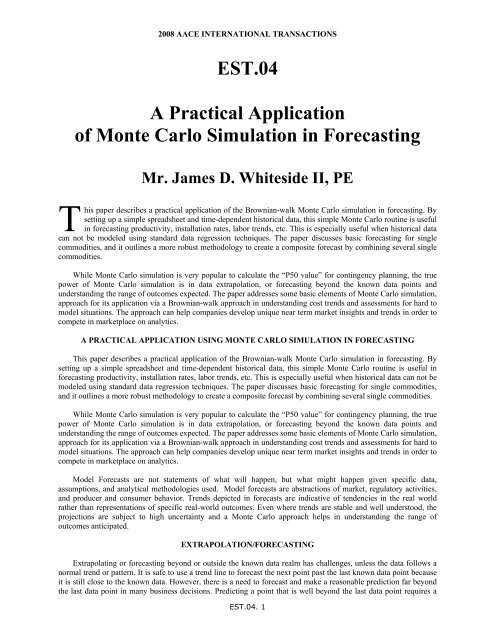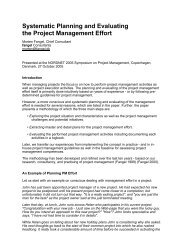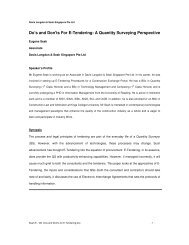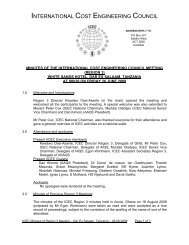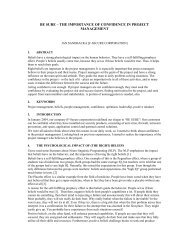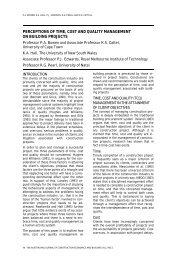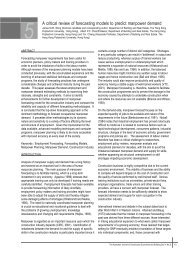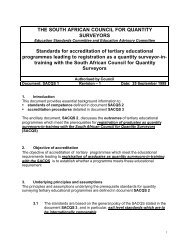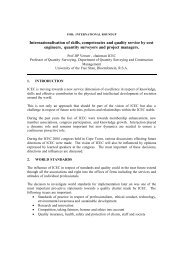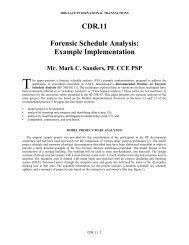A Practical Application of Monte Carlo Simulation in Forecasting
A Practical Application of Monte Carlo Simulation in Forecasting
A Practical Application of Monte Carlo Simulation in Forecasting
Create successful ePaper yourself
Turn your PDF publications into a flip-book with our unique Google optimized e-Paper software.
2008 AACE INTERNATIONAL TRANSACTIONSThis is the uniform probability distribution equation:Eq 2PRNG is the value returned from the portable random number generator (PRNG). S<strong>in</strong>ce most built-<strong>in</strong> randomnumber generators have flaws, only validated PRNGs should be used <strong>in</strong> <strong>Monte</strong> <strong>Carlo</strong> simulations.UNOBVIOUS ORDERThe most common argument used to argue aga<strong>in</strong>st forecast<strong>in</strong>g <strong>of</strong> near-term data is that it is highly volatile andhighly random. S<strong>in</strong>ce it is “highly unpredictable,” critics then argue forecast<strong>in</strong>g is unachievable and revert tojudgmental methods (probably the ultimate answer is somewhere <strong>in</strong> the middle). However, many people have neverseen an application based on Chaos Theory. The reason that the Brownian-walk equation could be consideredborder<strong>in</strong>g chaos is that it has the same basic elements as <strong>in</strong> the follow<strong>in</strong>g example <strong>of</strong> a Lorenz Attractor. A LorenzAttractor is based on three differential equations. Figure 3 represents only two <strong>of</strong> the three variables required, butthis paper is not go<strong>in</strong>g to address this further.Figure 3―Eng<strong>in</strong>eer<strong>in</strong>g Hours vs Direct Construction Labor HoursFigure 3―“Eng<strong>in</strong>eer<strong>in</strong>g Hours vs Direct Construction Labor Hours,” appears to be random and without order.However, when re-plott<strong>in</strong>g the data <strong>in</strong> figure 3 as shown <strong>in</strong> figure 4, “Lorenz Attractor” it appears ordered and notrandom at all. It serves as an important example <strong>of</strong> the ordered nature <strong>of</strong> some common “highly unpredictable” datasets. The po<strong>in</strong>t is that too many forecasts are ignored because the data appears too random to model and anyforecasts are therefore assumed to be flawed and unusable.EST.04. 5
2008 AACE INTERNATIONAL TRANSACTIONSFigure 4―Lorenz Attractor(Re-plott<strong>in</strong>g <strong>of</strong> Figure 3)FORECASTING RAW MODEThe Brownian-walk provides a slate <strong>of</strong> possible path outcomes as shown <strong>in</strong> figure 5, ”Units vs Time (RawMode).” This will be referred to as a “raw mode” because there is no attempt to correct the forecasts. The raw modeis a pure Brownian-walk output. The data represented by the curves <strong>in</strong> figure 5 are easier to forecast than theLorenz’s curves <strong>in</strong> figure 3 because they do not have the magnitude <strong>of</strong> peaks and valleys.The pathways <strong>in</strong> figure 5 resemble the curves <strong>in</strong> figure 3. Units can be a price, productivity value, rate <strong>of</strong>change, etc. Time can be weeks, months, years, etc. as long as it is a value that the unit data is regularly harvestedfor comparative purposes. For example, if stock price is analyzed for long-term forecast<strong>in</strong>g, time could be expressed<strong>in</strong> months. If stock price is analyzed for the affects that day traders have on this particular stock, then us<strong>in</strong>g hoursmay be more appropriate.EST.04. 6
2008 AACE INTERNATIONAL TRANSACTIONSTable 2―Compounded InterestThe question is how much more they will be <strong>in</strong> 5 months and 10 months. This model forecasts labor as reach<strong>in</strong>gits peak <strong>in</strong>crease today (time 90) and labor will cont<strong>in</strong>ue to decrease over the next 10 months. Equipment andmaterial will cont<strong>in</strong>ue to <strong>in</strong>crease for the next eight months. The material forecast exceeds equipment because it ismostly alloy-based material which has seen very high cost escalation <strong>in</strong> recent months.EST.04. 10
2008 AACE INTERNATIONAL TRANSACTIONSFigure 7―Composite ForecastThere are three basic applications for the forecasts represented <strong>in</strong> figure 7. The long-term forecast l<strong>in</strong>e isconservative and best suited for long range plann<strong>in</strong>g. The long-term forecast (black curve) is a simple trend l<strong>in</strong>e <strong>of</strong>the near-term forecast. The near-term forecast l<strong>in</strong>e (red curve) <strong>in</strong> figure 7 is the sum <strong>of</strong> the weighted values formaterial, equipment, and labor. The near-term forecast l<strong>in</strong>e can be best used for projects which will probablycomplete <strong>in</strong> the next five to ten months (possibly 1-2 years even). The data <strong>in</strong> the commodity forecasts can be placed<strong>in</strong>to project risk economic models.A CASE FOR MICROECONOMICSBrownian-walk is a great tool for microeconomic forecast<strong>in</strong>g. Microeconomics focuses on factors that affect thedecisions made by <strong>in</strong>dividuals and bus<strong>in</strong>esses. In this case, the <strong>in</strong>fluences <strong>of</strong> the near-term market pressures on thepric<strong>in</strong>g commodities. These factors are represented by the commodities <strong>in</strong> figure 7 and the near-term forecast l<strong>in</strong>e isthe aggregation.Macro economists study the movement and trends <strong>in</strong> the economy as a whole. They are generally <strong>in</strong> charge <strong>of</strong>sett<strong>in</strong>g the escalation long-range forecast. When macro economists evaluate a forecast, they project an aggregatedlong-term forecast as <strong>in</strong> figure 7.It appears that their general theory is that there will be market corrections forc<strong>in</strong>g the overall escalation to beless than half the value <strong>of</strong> the current market growth value. Therefore, they tend to default to an <strong>in</strong>flation valuearound 2.5 percent or 3 percent per year beyond year three because these values are useful <strong>in</strong> long-term forecast<strong>in</strong>gand bus<strong>in</strong>ess plann<strong>in</strong>g. The disruption <strong>of</strong> large pric<strong>in</strong>g sw<strong>in</strong>gs <strong>of</strong> a few smaller commodities muted by the overalleconomy.Macroeconomic forecast<strong>in</strong>g does not fit near-term forecast<strong>in</strong>g because projects have momentum. A project willnot automatically get refunds because the market was <strong>in</strong> decl<strong>in</strong>e after the project was started. The market may becompletely out <strong>of</strong> sync with the local or national economy.EST.04. 11


